The Effect of Perceived Real-Scene Environment of a River in a High-Density Urban Area on Emotions
Abstract
:1. Introduction
2. Materials and Methods
2.1. Research Context and Subjects
2.2. Experimental Design
2.3. Data Processing
3. Results
3.1. Physiological Feedback Results
3.1.1. The Mood Changes of the Riverside Tour
3.1.2. Visual Attraction of the Riverside Scene
3.2. Feedback Results of the Questionnaire
4. Discussion and Analysis
4.1. The Influence of High-Density Urban Riverside Landscape on Mood
4.2. Analysis of the Mechanism of Different Types of Riverside Landscapes on Emotions
4.3. Determination of Real-Scene Emotion Perception under the New Technology
4.4. Riverfront Landscape Planning and Design Recommendations
5. Conclusions
Author Contributions
Funding
Institutional Review Board Statement
Informed Consent Statement
Data Availability Statement
Acknowledgments
Conflicts of Interest
References
- Li, M.; Ye, C. Threshold Standard and Global Distribution of High-Density Cities. World Reg. Stud. 2015, 24, 38–45. [Google Scholar]
- China Statistics Press. Beijing Regional Statistical Yearbook 2022; China Statistics Press: Beijing, China, 2022. [Google Scholar]
- Gao, Y.; Liu, K.; Zhou, P.; Xie, H. The effects of residential built environment on supporting physical activity diversity in high-density cities: A case study in Shenzhen, China. Int. J. Environ. Res. Public Health 2021, 18, 6676. [Google Scholar] [CrossRef] [PubMed]
- Fan, P.; Lee, Y.-C.; Ouyang, Z.; Huang, S.-L. Compact and green urban development—Towards a framework to assess urban development for a high-density metropolis. Environ. Res. Lett. 2019, 14, 115006. [Google Scholar] [CrossRef]
- Chen, C.; Li, H.; Luo, W.; Xie, J.; Yao, J.; Wu, L.; Xia, Y. Predicting the effect of street environment on residents’ mood states in large urban areas using machine learning and street view images. Sci. Total Environ. 2022, 816, 151605. [Google Scholar] [CrossRef]
- Peschardt, K.K.; Stigsdotter, U.K. Associations between park characteristics and perceived restorativeness of small public urban green spaces. Landsc. Urban Plan. 2013, 112, 26–39. [Google Scholar] [CrossRef]
- Wang, Z. Emotion analysis-based decision support system for public perception evaluation in urban planning and design using social media text. Soft Comput. 2023. [Google Scholar] [CrossRef]
- Yeom, S.; Kim, H.; Hong, T.; Park, H.S.; Lee, D.-E. An integrated psychological score for occupants based on their perception and emotional response according to the windows’ outdoor view size. Build. Environ. 2020, 180, 107019. [Google Scholar] [CrossRef]
- Zeng, X.; Zhong, Y.; Yang, L.; Wei, J.; Tang, X. Analysis of Forest Landscape Preferences and Emotional Features of Chinese Forest Recreationists Based on Deep Learning of Geotagged Photos. Forests 2022, 13, 892. [Google Scholar] [CrossRef]
- Yin, J.; Bratman, G.N.; Browning, M.H.; Spengler, J.D.; Olvera-Alvarez, H.A. Stress recovery from virtual exposure to a brown (desert) environment versus a green environment. J. Environ. Psychol. 2022, 81, 101775. [Google Scholar] [CrossRef]
- McSweeney, J.; Johnson, S.; Sherry, S.; Singleton, J.; Rainham, D. Indoor nature exposure and influence on physiological stress markers. Int. J. Environ. Health Res. 2021, 31, 636–650. [Google Scholar] [CrossRef]
- Parasuraman, R.; Rizzo, M. Neuroergonomics: The Brain at Work; Oxford University Press: Oxford, UK, 2006; Volume 3. [Google Scholar]
- Wang, X.; Rodiek, S.; Wu, C.; Chen, Y.; Li, Y. Stress recovery and restorative effects of viewing different urban park scenes in Shanghai, China. Urban For. Urban Green. 2016, 15, 112–122. [Google Scholar] [CrossRef]
- Kim, M.; Cheon, S.; Kang, Y. Use of electroencephalography (EEG) for the analysis of emotional perception and fear to nightscapes. Sustainability 2019, 11, 233. [Google Scholar] [CrossRef]
- Zhang, J.; Li, Y. The Impact of Campus Outdoor Space Features on Students’ Emotions Based on the Emotion Map. Int. J. Environ. Res. Public Health 2023, 20, 4277. [Google Scholar] [CrossRef] [PubMed]
- Zhuang, J.; Qiao, L.; Zhang, X.; Su, Y.; Xia, Y. Effects of visual attributes of flower borders in urban vegetation landscapes on aesthetic preference and emotional perception. Int. J. Environ. Res. Public Health 2021, 18, 9318. [Google Scholar] [CrossRef] [PubMed]
- Li, D.; Sullivan, W.C. Impact of views to school landscapes on recovery from stress and mental fatigue. Landsc. Urban Plan. 2016, 148, 149–158. [Google Scholar] [CrossRef]
- Deng, L.; Li, X.; Luo, H.; Fu, E.-K.; Ma, J.; Sun, L.-X.; Huang, Z.; Cai, S.-Z.; Jia, Y. Empirical study of landscape types, landscape elements and landscape components of the urban park promoting physiological and psychological restoration. Urban For. Urban Green. 2020, 48, 126488. [Google Scholar] [CrossRef]
- Xi, W.; Yanlong, Z.; Zhao, R.; Niu, L. Study on the Effects of Four Campus Green Landscapes on College Students’ Physiological and Psychological Indicators. Chin. Landsc. Arch. 2020, 36, 92–97. [Google Scholar]
- Kabisch, N.; Pueffel, C.; Masztalerz, O.; Hemmerling, J.; Kraemer, R. Physiological and psychological effects of visits to different urban green and street environments in older people: A field experiment in a dense inner-city area. Landsc. Urban Plan. 2021, 207, 103998. [Google Scholar] [CrossRef]
- Jiang, M.; Hassan, A.; Chen, Q.; Liu, Y. Effects of different landscape visual stimuli on psychophysiological responses in Chinese students. Indoor Built Environ. 2020, 29, 1006–1016. [Google Scholar] [CrossRef]
- Jo, H.; Ikei, H.; Miyazaki, Y. Physiological and psychological Benefits of viewing an autumn foliage mountain landscape image among young women. Forests 2022, 13, 1492. [Google Scholar] [CrossRef]
- Mitrovic, A.; Hegelmaier, L.M.; Leder, H.; Pelowski, M. Does beauty capture the eye, even if it’s not (overtly) adaptive? A comparative eye-tracking study of spontaneous attention and visual preference with VAST abstract art. Acta Psychol. 2020, 209, 103133. [Google Scholar] [CrossRef] [PubMed]
- Zheng, L.; Zhao, Y.; Duan, R.; Yang, W.; Wang, Z.; Su, J. The influence path of community green exposure index on activity behavior under multi-dimensional spatial perception. Front. Public Health 2023, 11, 1243838. [Google Scholar] [CrossRef] [PubMed]
- Liu, Q.; Zhu, Z.; Zeng, X.; Zhuo, Z.; Ye, B.; Fang, L.; Huang, Q.; Lai, P. The impact of landscape complexity on preference ratings and eye fixation of various urban green space settings. Urban For. Urban Green. 2021, 66, 127411. [Google Scholar] [CrossRef]
- Zhou, X.; Cen, Q.; Qiu, H. Effects of urban waterfront park landscape elements on visual behavior and public preference: Evidence from eye-tracking experiments. Urban For. Urban Green. 2023, 82, 127889. [Google Scholar] [CrossRef]
- Hartig, T.; Evans, G.W.; Jamner, L.D.; Davis, D.S.; Gärling, T. Tracking restoration in natural and urban field settings. J. Environ. Psychol. 2003, 23, 109–123. [Google Scholar] [CrossRef]
- Li, X.; Wang, X.; Jiang, X.; Han, J.; Wang, Z.; Wu, D.; Lin, Q.; Li, L.; Zhang, S.; Dong, Y. Prediction of riverside greenway landscape aesthetic quality of urban canalized rivers using environmental modeling. J. Clean. Prod. 2022, 367, 133066. [Google Scholar] [CrossRef]
- Liu, Y.; Kaneda, T. Using agent-based simulation for public space design based on the Shanghai Bund waterfront crowd disaster. AI EDAM 2020, 34, 176–190. [Google Scholar] [CrossRef]
- Everard, M.; Moggridge, H.L. Rediscovering the value of urban rivers. Urban Ecosyst. 2012, 15, 293–314. [Google Scholar] [CrossRef]
- Gehl, J. Life between Buildings; Island Press: Washington DC, USA, 2011. [Google Scholar]
- Xu, D.; Li, Y. Experts and public aesthetic differences based on SD-SBE method. Chin. Landsc. Archit. 2014, 30, 52–56. [Google Scholar]
- Barton, J.; Bragg, R.; Wood, C.; Pretty, J. Green Exercise: Linking Nature, Health and Well-Being; Routledge: London, UK, 2016. [Google Scholar]
- Chiang, Y.-C.; Li, D.; Jane, H.-A. Wild or tended nature? The effects of landscape location and vegetation density on physiological and psychological responses. Landsc. Urban Plan. 2017, 167, 72–83. [Google Scholar] [CrossRef]
- Li, X.; Zhang, X.; Jia, T. Humanization of nature: Testing the influences of urban park characteristics and psychological factors on collegers’ perceived restoration. Urban For. Urban Green. 2023, 79, 127806. [Google Scholar] [CrossRef]
- Lyu, P.-H.; Zhang, M.-Z.; Wang, T.-R.; Zhang, X.-F.; Ye, C.-D. Research Trends, Knowledge Base, and Hotspot Evolution of Urban Renewal: A Bibliometric Approach. J. Urban Plan. Dev. 2023, 149, 04023033. [Google Scholar] [CrossRef]
- Zheng, C.; Yuelai, L.; Song, L. A review of landscape visual resource planning and design methods in the united states and potential improvement via new techniques. Landsc. Archit. 2015, 5, 111–117. [Google Scholar]
- Du, Z.; Lin, B.G.; Chen, Z.Y. Impact of urban square small-scale waters on human health. J. Chin. Urban For. 2022, 20, 54–60. [Google Scholar]
- Browning, M.H.; Mimnaugh, K.J.; Van Riper, C.J.; Laurent, H.K.; LaValle, S.M. Can simulated nature support mental health? Comparing short, single-doses of 360-degree nature videos in virtual reality with the outdoors. Front. Psychol. 2020, 10, 2667. [Google Scholar] [CrossRef] [PubMed]
- Xu, J.; Li, M.; Cao, K.; Zhou, F.; Lv, B.; Lu, Z.; Cui, Z.; Zhang, K. A VR Experimental Study on the Influence of Chinese Hotel Interior Color Design on Customers’ Emotional Experience. Buildings 2022, 12, 984. [Google Scholar] [CrossRef]
- Chirico, A.; Gaggioli, A. When virtual feels real: Comparing emotional responses and presence in virtual and natural environments. Cyberpsychology Behav. Soc. Netw. 2019, 22, 220–226. [Google Scholar] [CrossRef]
- Antonelli, M.; Barbieri, G.; Donelli, D. Effects of forest bathing (shinrin-yoku) on levels of cortisol as a stress biomarker: A systematic review and meta-analysis. Int. J. Biometeorol. 2019, 63, 1117–1134. [Google Scholar] [CrossRef]
- Yuan, S.; Browning, M.H.; McAnirlin, O.; Sindelar, K.; Shin, S.; Drong, G.; Hoptman, D.; Heller, W. A virtual reality investigation of factors influencing landscape preferences: Natural elements, emotions, and media creation. Landsc. Urban Plan. 2023, 230, 104616. [Google Scholar] [CrossRef]
- Zeng, C.; Lin, W.; Li, N.; Wen, Y.; Wang, Y.; Jiang, W.; Zhang, J.; Zhong, H.; Chen, X.; Luo, W. Electroencephalography (Eeg)-based neural emotional response to the vegetation density and integrated sound environment in a green space. Forests 2021, 12, 1380. [Google Scholar] [CrossRef]
- Li, Y.; Zhang, J.; Jiang, B.; Li, H.; Zhao, B. Do All Types of Restorative Environments in the Urban Park Provide the Same Level of Benefits for Young Adults? A Field Experiment in Nanjing, China. Forests 2023, 14, 1400. [Google Scholar] [CrossRef]
- Akiba, H.T.; Costa, M.F.; Gomes, J.S.; Oda, E.; Simurro, P.B.; Dias, A.M. Neural correlates of preference: A transmodal validation study. Front. Hum. Neurosci. 2019, 13, 73. [Google Scholar] [CrossRef] [PubMed]
- Antonson, H.; Ahlström, C.; Mårdh, S.; Blomqvist, G.; Wiklund, M. Landscape heritage objects’ effect on driving: A combined driving simulator and questionnaire study. Accid. Anal. Prev. 2014, 62, 168–177. [Google Scholar] [CrossRef] [PubMed]
- Jafari, M.J.; Zaeri, F.; Jafari, A.H.; Payandeh Najafabadi, A.T.; Al-Qaisi, S.; Hassanzadeh-Rangi, N. Assessment and monitoring of mental workload in subway train operations using physiological, subjective, and performance measures. Hum. Factors Ergon. Manuf. Serv. Ind. 2020, 30, 165–175. [Google Scholar] [CrossRef]
- Watson, D.; Clark, L.A.; Tellegen, A. Development and validation of brief measures of positive and negative affect: The PANAS scales. J. Personal. Soc. Psychol. 1988, 54, 1063. [Google Scholar] [CrossRef] [PubMed]
- Russell, J.A. A circumplex model of affect. J. Personal. Soc. Psychol. 1980, 39, 1161. [Google Scholar] [CrossRef]
- Wang, K.Y.; Ho, Y.L.; Huang, Y.D.; Fang, W.C. Design of intelligent EEG system for human emotion recognition with convolutional neural network. In Proceedings of the 2019 IEEE International Conference on Artificial Intelligence Circuits and Systems (AICAS), Hsinchu, Taiwan, 18–20 March 2019; pp. 142–145. [Google Scholar] [CrossRef]
- Gladwell, V.; Brown, D.; Barton, J.L.; Tarvainen, M.; Kuoppa, P.; Pretty, J.; Suddaby, J.; Sandercock, G. The effects of views of nature on autonomic control. Eur. J. Appl. Physiol. 2012, 112, 3379–3386. [Google Scholar] [CrossRef] [PubMed]
- Kondolf, G.M.; Pinto, P.J. The social connectivity of urban rivers. Geomorphology 2017, 277, 182–196. [Google Scholar] [CrossRef]
- Li, X.; Wang, Z.; Wu, D.; Tan, L.; Lin, J. A study on the stress relief of young people by urban riverwalk based on physiological feedback. Chin. Gard. 2022, 38, 86. [Google Scholar]
- Zhang, Y.; Ong, G.X.; Jin, Z.; Seah, C.M.; Chua, T.S. The effects of urban greenway environment on recreational activities in tropical high-density Singapore: A computer vision approach. Urban For. Urban Green. 2022, 75, 127678. [Google Scholar] [CrossRef]
- Li, X.; Li, L.; Wang, X.; Lin, Q.; Wu, D.; Dong, Y.; Han, S. Visual quality evaluation model of an urban river landscape based on random forest. Ecol. Indic. 2021, 133, 108381. [Google Scholar] [CrossRef]
- Acar, C.; Kurdoglu, B.C.; Kurdoglu, O.; Acar, H. Public preferences for visual quality and management in the Kackar Mountains National Park (Turkey). Int. J. Sustain. Dev. World Ecol. 2006, 13, 499–512. [Google Scholar] [CrossRef]
- Parsons, R. Conflict between ecological sustainability and environmental aesthetics: Conundrum, canärd or curiosity. Landsc. Urban Plan. 1995, 32, 227–244. [Google Scholar] [CrossRef]
- Allahyar, M.; Kazemi, F. Effect of landscape design elements on promoting neuropsychological health of children. Urban For. Urban Green. 2021, 65, 127333. [Google Scholar] [CrossRef]
- Fang, X.; Ma, Q.; Wu, L.; Liu, X. Distributional environmental justice of residential walking space: The lens of urban ecosystem services supply and demand. J. Environ. Manag. 2023, 329, 117050. [Google Scholar] [CrossRef] [PubMed]
- Sonntag-Öström, E.; Stenlund, T.; Nordin, M.; Lundell, Y.; Ahlgren, C.; Fjellman-Wiklund, A.; Järvholm, L.S.; Dolling, A. “Nature’s effect on my mind”–Patients’ qualitative experiences of a forest-based rehabilitation programme. Urban For. Urban Green. 2015, 14, 607–614. [Google Scholar] [CrossRef]
- Saeedi, I.; Dabbagh, E. Modeling the relationships between hardscape color and user satisfaction in urban parks. Environ. Dev. Sustain. 2021, 23, 6535–6552. [Google Scholar] [CrossRef]
- Nisa’minhad, K.; Ali, S.H.M.; Reaz, M.B.I. A design framework for human emotion recognition using electrocardiogram and skin conductance response signals. J. Eng. Sci. Technol. 2017, 12, 3102–3119. [Google Scholar]
- Wang, W.; Chen, H.; Wang, L.; Wang, S. Integrating multiple models into computational fluid dynamics for fine three-dimensional simulation of urban waterfront wind environments: A case study in Hangzhou, China. Sustain. Cities Soc. 2022, 85, 104088. [Google Scholar] [CrossRef]


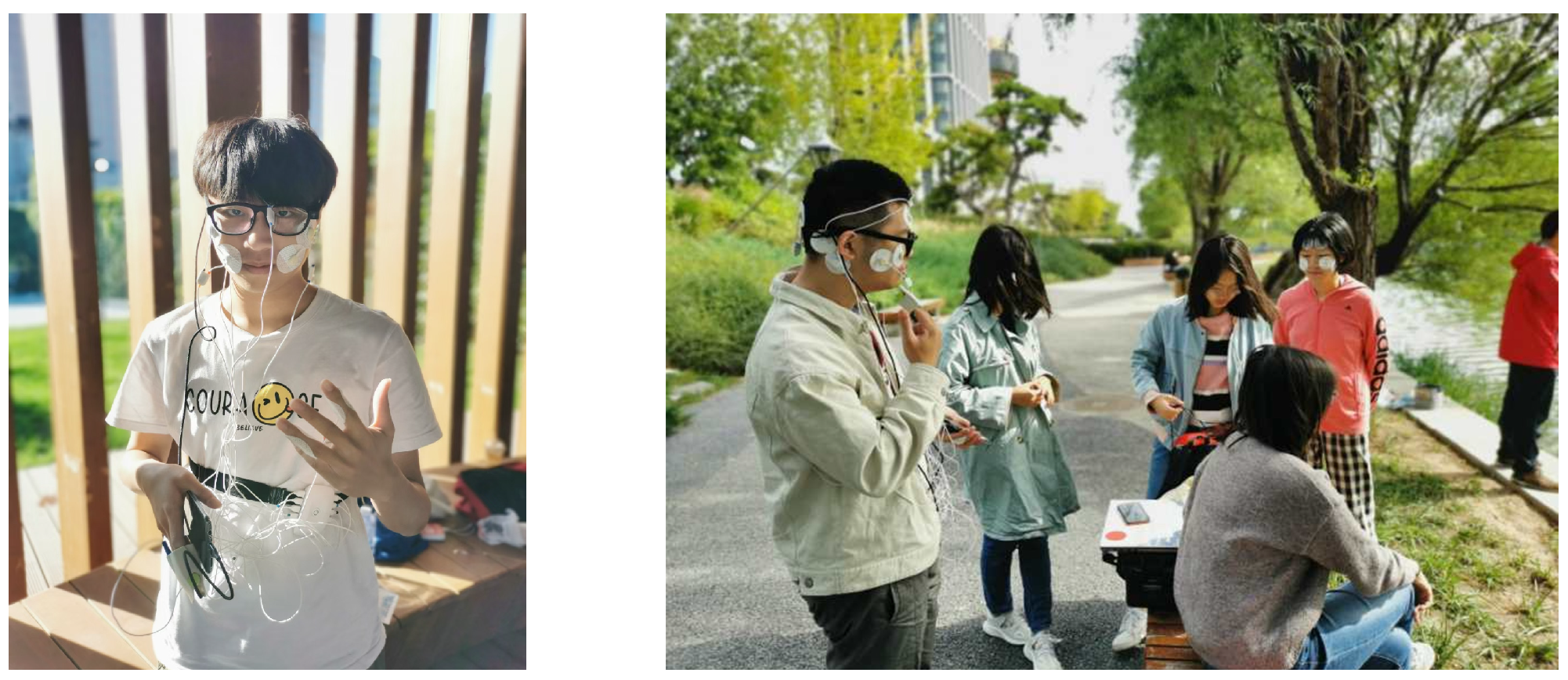
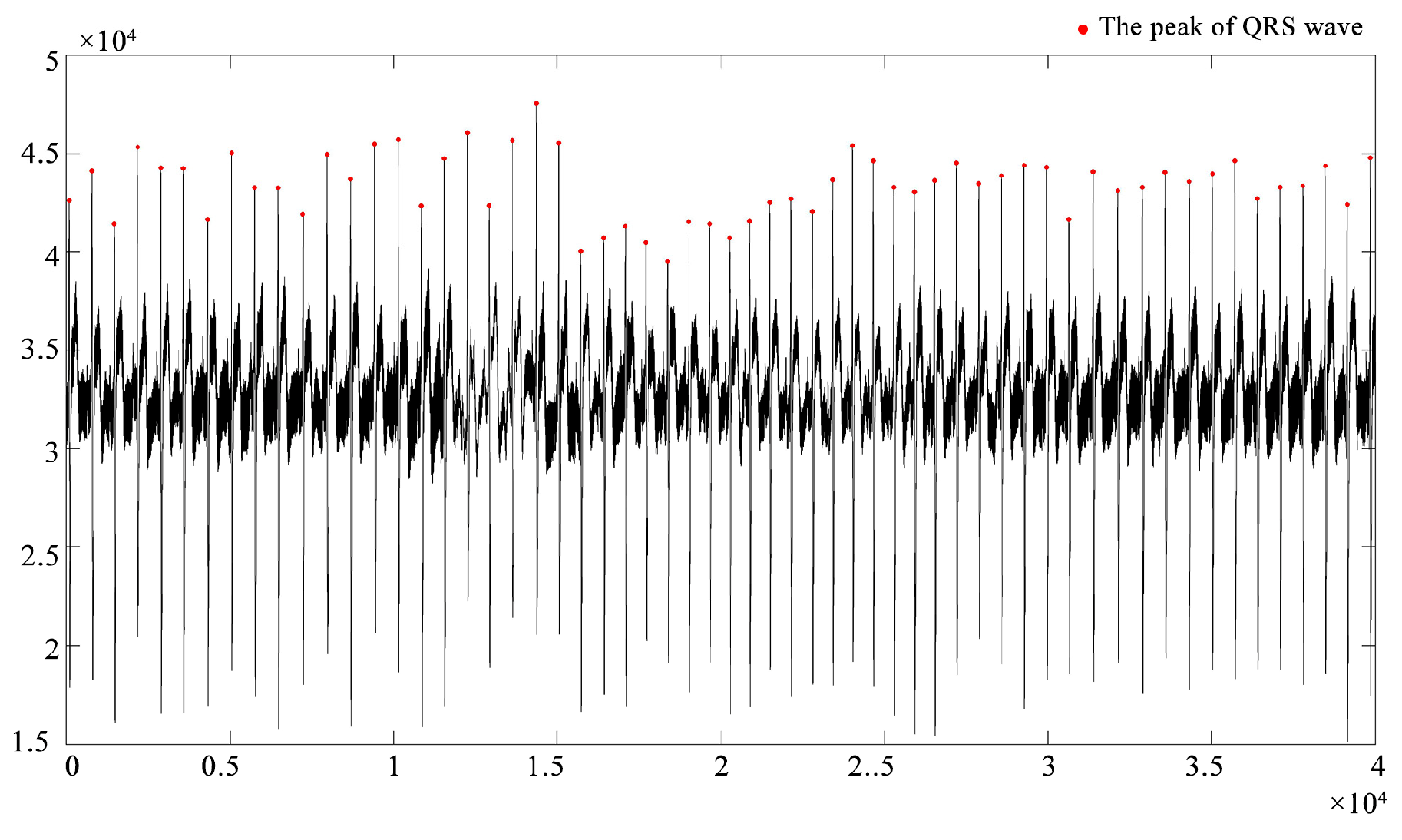
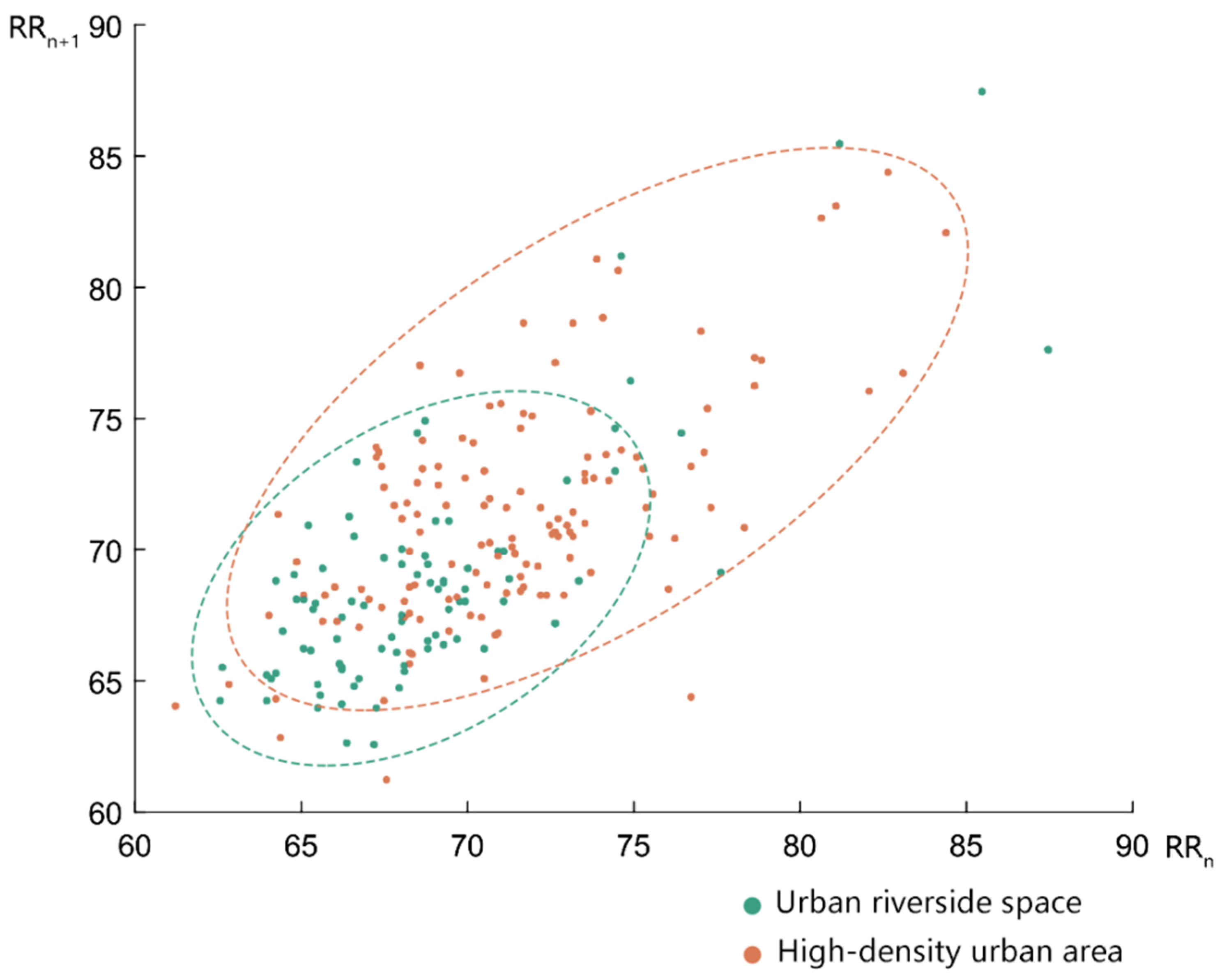

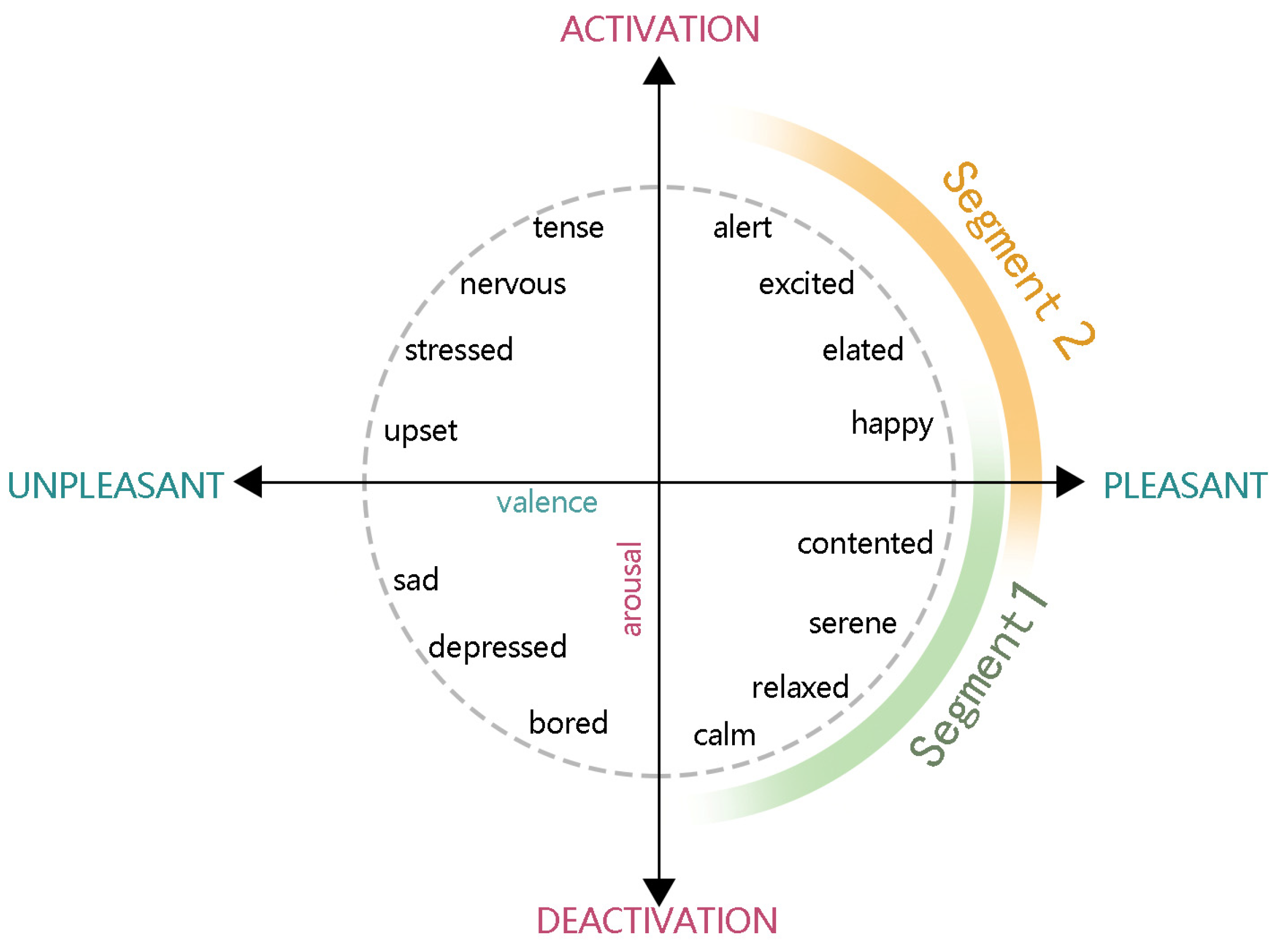
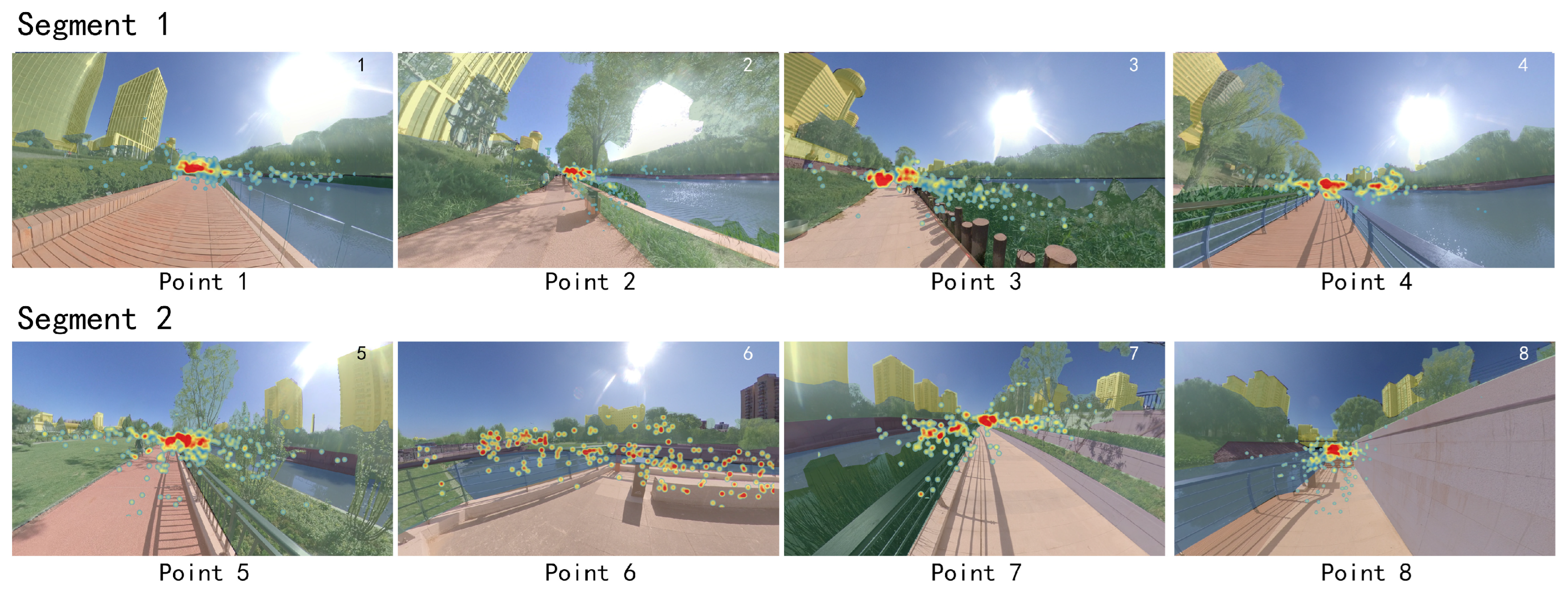


| Positive Emotions (P.A.) | Negative Emotions (N.A.) |
|---|---|
| Interested | Afraid |
| Excited | Jittery |
| Strong | Nervous |
| Enthusiastic | Ashamed |
| Proud | Irritable |
| Alert | Hostile |
| Inspired | Scared |
| Determined | Guilty |
| Attentive | Upset |
| Active | Distressed |
| Levene’s-Test | Mean T-Test | |||||||||
|---|---|---|---|---|---|---|---|---|---|---|
| F | Sig. | t | df | Sig. (2-Tailed) | Mean Deviation | Standard Error | [95% Conf. Interval] | |||
| SDNN | Equal Variances Assumed | 0.221 | 0.640 | −3.103 | 248 | 0.003 ** | −7.262 | 2.340 | −11.918 | −2.606 |
| Equal Variances Not Assumed | −3.099 | 241.586 | 0.003 ** | −7.262 | 2.343 | −11.925 | −2.599 | |||
| RMSSD | Equal Variances Assumed | 0.185 | 0.668 | −2.448 | 248 | 0.017 * | −6.181 | 2.525 | −11.204 | −1.157 |
| Equal Variances Not Assumed | −2.447 | 243.797 | 0.017 * | −6.181 | 2.526 | −11.207 | −1.154 | |||
| LF/HF | Equal Variances Assumed | 2.488 | 0.119 | −5.568 | 248 | 0.000 ** | −0.391 | 0.070 | −0.531 | −0.251 |
| Equal Variances Not Assumed | −5.542 | 214.529 | 0.000 ** | −0.391 | 0.071 | −0.532 | −0.250 | |||
| HR | Equal Variances Assumed | 0.067 | 0.797 | −11.375 | 248 | 0.000 ** | −17.740 | 1.560 | −20.843 | −14.637 |
| Equal Variances Not Assumed | −11.387 | 241.091 | 0.000 ** | −17.740 | 1.558 | −20.840 | −14.640 | |||
| Index | Group | N | Mean | Std. Err. | Std. Dev. |
|---|---|---|---|---|---|
| SDNN | 1 | 126 | 32.595 | 10.146 | 1.566 |
| 2 | 124 | 39.857 | 11.161 | 1.743 | |
| RMSSD | 1 | 126 | 26.944 | 11.234 | 1.733 |
| 2 | 124 | 33.124 | 11.765 | 1.837 | |
| LF/HF | 1 | 126 | 0.855 | 0.253 | 0.039 |
| 2 | 124 | 1.246 | 0.376 | 0.059 | |
| HR | 1 | 126 | 84.36 | 7.397 | 1.141 |
| 2 | 124 | 102.10 | 6.789 | 1.060 |
Disclaimer/Publisher’s Note: The statements, opinions and data contained in all publications are solely those of the individual author(s) and contributor(s) and not of MDPI and/or the editor(s). MDPI and/or the editor(s) disclaim responsibility for any injury to people or property resulting from any ideas, methods, instructions or products referred to in the content. |
© 2023 by the authors. Licensee MDPI, Basel, Switzerland. This article is an open access article distributed under the terms and conditions of the Creative Commons Attribution (CC BY) license (https://creativecommons.org/licenses/by/4.0/).
Share and Cite
Li, M.; Liu, R.; Li, X.; Zhang, S.; Wu, D. The Effect of Perceived Real-Scene Environment of a River in a High-Density Urban Area on Emotions. Land 2024, 13, 35. https://doi.org/10.3390/land13010035
Li M, Liu R, Li X, Zhang S, Wu D. The Effect of Perceived Real-Scene Environment of a River in a High-Density Urban Area on Emotions. Land. 2024; 13(1):35. https://doi.org/10.3390/land13010035
Chicago/Turabian StyleLi, Mengyixin, Rui Liu, Xin Li, Shiyang Zhang, and Danzi Wu. 2024. "The Effect of Perceived Real-Scene Environment of a River in a High-Density Urban Area on Emotions" Land 13, no. 1: 35. https://doi.org/10.3390/land13010035
APA StyleLi, M., Liu, R., Li, X., Zhang, S., & Wu, D. (2024). The Effect of Perceived Real-Scene Environment of a River in a High-Density Urban Area on Emotions. Land, 13(1), 35. https://doi.org/10.3390/land13010035






